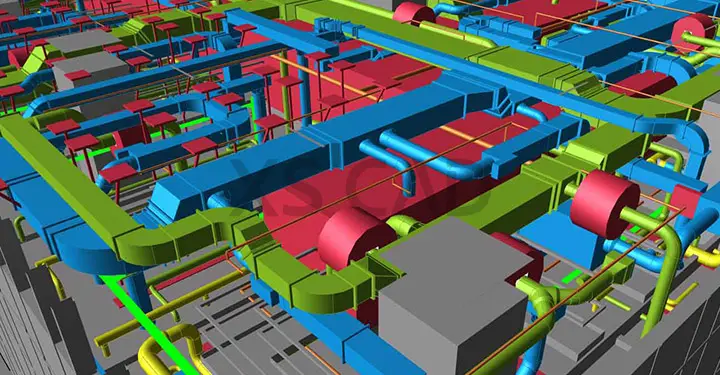Our Articles

3D MEP Coordination: An Effective Way to Reduce Rework and Increase Efficiency
Maintaining deadlines in the AEC (architecture, engineering, construction) industry will be of paramount importance as global firms adjust to changing environments. Reducing rework and increasing process efficiency will go a long way in achieving this. Design and construction-related rework can adversely affect productivity, profitability and timely project completion for both contractors and owners. It also impacts designers, subcontractors, MEP (mechanical, electrical, plumbing), or M&E, engineers, consultants and the entire downstream chain. In larger and more complex projects, the design-build rework can negatively influence the entire project workflow, delay project delivery and cost more than what was originally estimated. When building services coordination is provided by experienced building services design consultants, the bulk of the challenge is taken care of.
Building services, namely mechanical, electrical, plumbing and fire safety, are vital building features. These systems are typically laid out in confined spaces that may lead to clashes between them. Detecting and resolving clashes between building services systems is the primary purpose of MEP coordination, an important and necessary review process. Detailed knowledge of design, components, operations and the maintenance requirements of the building is required for MEP coordination.
A few examples of MEP components that need to be considered during MEP coordination are as follows:
Updated designs of building services are a must for MEP coordination. At some point, clashes may be detected, where components of different services occupy the same space. Detecting potential clashes early in the design stage will save unnecessary expenses and delays later when installation begins.
Architectural and structural constraints must also be considered when locations are assigned during MEP coordination, and one of the most effective methods of following a comprehensive process to this end is using a Building Information Modelling (BIM) approach.
What’s that?
Well, a BIM approach provides a virtual 3D building model, which can be modified easily without having to repeatedly re-draw the design. Changes made to any part of the model will be parametrically adjusted throughout the model, and potential clashes between trades and disciplines will be detected. Further, project stakeholders, such as MEP engineers, architects and structural engineers, can easily communicate, share data and collaborate in real time early in the design development stage, saving time and money.
Certain software platforms, such as Autodesk’s Revit, can help develop clash free drawings and a smooth design documentation workflow, helping to improve efficiency.
As mechanical, electrical, and plumbing systems account for a significant value of the project, the prudent use of BIM tools to effectively coordinate MEP (M&E) systems helps reduce rework and increase productivity. On the other hand, the lack of well-planned interdisciplinary MEP (M&E) coordination results in duplication of efforts, major interferences and design clashes on site, as well as fabrication changes and errors.
Since BIM requires comprehensive pre-construction planning and multidisciplinary coordination, its adoption by the MEP (M&E) team increases technical interoperability among various members during building services coordination. In BIM-led MEP (M&E) coordination, building services designers, consultants, and subcontractors are involved during the design and planning stage. One of the most crucial factors for an effective and accurate coordination exercise is to decide on a specific protocol for creating virtual architectural, structural, mechanical, electrical, plumbing and fire protection models of the same facility. Subsequently, the team should agree on mechanisms to merge the models from different trades and create a combined coordinated services MEP model.
For instance, the designers use Revit Architecture application to prepare architectural BIM models that accurately represent elements, such as:
Furthermore, each of these elements has a range of parameters, including thickness, height, materials and texture, among others. Using this architectural model as a reference point, a structural model will be created using Revit Structure, which features vertical and horizontal structural framing, foundations and slabs.
Subsequently, the MEP (M&E) contractors and subcontractors design separate models for mechanical, electrical and plumbing systems using 3D MEP modelling software (such Autodesk MEP and Revit MEP). Usually, the mechanical models include:
The electrical models will represent details concerning:
The plumbing system model includes:
Once the respective architectural, structural and building services models are in place, they have to be merged and taken into a clash detection application and specialist interference-checking application, such as Autodesk Navisworks. Any clashes and inconsistencies, including the geometry-related hard clashes, the clearance clashes and workflow clashes, are detected. Following the clash detection, the combined services models and drawing sets have to be prepared to show how MEP (M&E) systems fit together in the same space.
As a result, the MEP (M&E) installers and fabricators receive well-coordinated and clash-free building services drawings on site, which drastically reduces the number of installation conflicts in the field. Additionally, MEP (M&E) BIM coordination leads to a greater number of assemblies being prefabricated off-site in a controlled factory environment, which in turn improves the logistical flow on site. Moreover, another positive outcome of the BIM-driven 3D MEP (M&E) coordination exercise is relatively fewer change orders and RFIs (request for information).
The positive effects of MEP (M&E) BIM coordination make the design-build process more efficient by increasing the project’s schedule compliance whilst reducing design and construction-related rework. Experienced and well-qualified building services design consultants can deliver high-quality building services coordination in a cost-effective and timely manner, increasing the efficiency of the design process.
XS CAD has valuable experience providing 3D BIM coordination services and building services coordinated drawings for global firms. Our range of services for building services design consultants and contractors across the world include MEP drafting, electrical drafting, public health system drafting and 3D M&E (MEP) coordination using BIM 360 Design.

